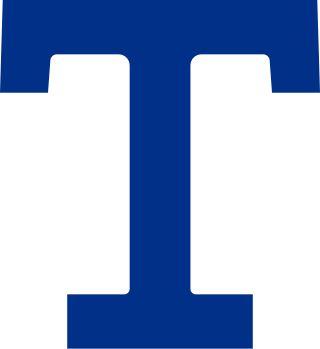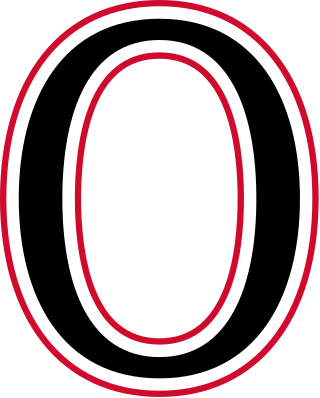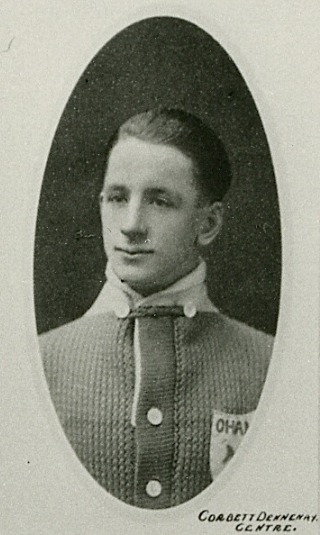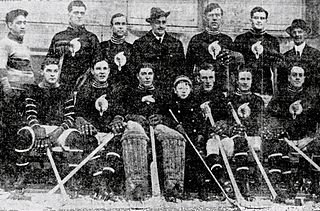
The Toronto Arenas or Torontos were a professional men's ice hockey team that played in the first two seasons of the National Hockey League (NHL). It was operated by the owner of the Arena Gardens, the Toronto Arena Company. As the ownership of the National Hockey Association (NHA) Toronto Blueshirts franchise was in dispute, the new NHL league was started, and a temporary Toronto franchise was operated. The NHL itself was intended to only be a one-year entity until the NHA could be reactivated, although it never was.
The National Hockey Association (NHA), initially the National Hockey Association of Canada Limited, was a professional ice hockey organization with teams in Ontario and Quebec, Canada. It is the direct predecessor of today's National Hockey League (NHL) and much of the business processes of the NHL today are based on the NHA. Founded in 1909 by Ambrose O'Brien, the NHA introduced 'six-man hockey' by removing the 'rover' position in 1911. During its lifetime, the league coped with competition for players with the rival Pacific Coast Hockey Association (PCHA), the enlistment of players for World War I and disagreements between owners. The disagreements between owners came to a head in 1917, when the NHA suspended operations in order to get rid of an unwanted owner, Eddie Livingstone.
The 1917–18 NHL season was the first season of the National Hockey League (NHL) professional ice hockey league. The league was formed after the suspension of the National Hockey Association (NHA). Play was held in two halves, December 19 to February 4, and February 6 to March 6. The Canadiens won the first half, and Toronto the second half. The season was contested by four teams, down from six in the previous season, finishing with only three, in Montreal, Ottawa and Toronto. The Montreal Wanderers withdrew early in January 1918 after their rink, the Westmount Arena, burned down. Toronto won the NHL playoff and then won the Stanley Cup, by defeating the PCHA's Vancouver Millionaires three games to two in a best-of-five series.

The Toronto Hockey Club, known as the Torontos and the Toronto Blueshirts, was a professional ice hockey team based in Toronto. They were a member of the National Hockey Association (NHA). The club was founded in 1911 and began operations in 1912. The club won its sole Stanley Cup championship in 1914.

Edward James Livingstone was a Canadian sports team owner and manager. He was the principal owner of the Toronto Shamrocks and the Toronto Blueshirts professional ice hockey clubs of the National Hockey Association (NHA), where his battles with his fellow owners led them to create the National Hockey League.

Harold Hugh Cameron was a Canadian ice hockey defenceman who played professionally for the Toronto Blueshirts, Toronto Arenas, Ottawa Senators, Toronto St. Pats, and Montreal Canadiens. Cameron won three Stanley Cups in his career: his first as a member of the 1913–14 Toronto Blueshirts, his second as a member of the 1917–18 Blueshirts (Arenas), and his third as a member of the 1921–22 Toronto St. Pats.

John Phillip "Jack" Walker was a Canadian professional ice hockey forward who played for the Toronto Blueshirts, Seattle Metropolitans, Victoria Cougars, and Detroit Cougars. He played in all the big professional leagues at the time: the National Hockey Association (NHA), Pacific Coast Hockey Association (PCHA), Western Canada Hockey League (WCHL), and National Hockey League (NHL).

The Ottawa Senators were an ice hockey team based in Ottawa, which existed from 1883 to 1954. The club was the first hockey club in Ontario, a founding member of the National Hockey League (NHL) and played in the NHL from 1917 until 1934. The club, which was officially the Ottawa Hockey Club, was known by several nicknames, including the Generals in the 1890s, the Silver Seven from 1903 to 1907 and the Senators dating from 1908.
The 1911–12 NHA season was the third season of the National Hockey Association (NHA). Four teams played 18 games each. The Quebec Bulldogs would win the league championship and take over the Stanley Cup.

Charles Corbett "Corb" Denneny was a Canadian professional ice hockey forward who played professionally from 1912 to 1931, including nine seasons in the National Hockey League (NHL) for the Toronto Arenas, Toronto St. Pats, Hamilton Tigers and Chicago Black Hawks. Corbett also played for the Vancouver Maroons of the Pacific Coast Hockey Association (PCHA) and the Saskatoon Sheiks of Western Canada Hockey League. He twice won the Stanley Cup with the original versions of the NHL's Toronto franchise.
The 1915–16 NHA season was the seventh season of the National Hockey Association. Five teams played a 24 game schedule. Montreal Canadiens won the league championship and defeated the Portland Rosebuds to win their first ever Stanley Cup.

Donald John Smith was a Canadian professional ice hockey player. Smith was one of the earliest professional ice hockey players, playing professionally in the first decade of the 1900s. Smith played in the National Hockey League and its predecessor National Hockey Association for the Montreal Canadiens, Montreal Shamrocks, Montreal Wanderers and Renfrew Creamery Kings.
The 1918 Stanley Cup Finals was contested by the National Hockey League (NHL) champion Toronto and the Pacific Coast Hockey Association (PCHA) champion Vancouver Millionaires. In a series held entirely in Toronto, the Toronto team won the series by three games to two in the best-of-five game series to win the Stanley Cup. It was the first series contested by the new NHL and subsequently the first Stanley Cup win by the Toronto NHL franchise team.
The 1916–17 NHA season was the eighth and final season of the National Hockey Association. Six teams were to play two half-seasons of ten games each, but this was disrupted and only four teams finished the season. The Montreal Canadiens defeated the Ottawa Senators in a playoff to win the NHA championship.

The Tecumseh Hockey Club, also known as the Toronto Tecumsehs and nicknamed the Indians, were a team in the National Hockey Association in 1912–13. They then became the Toronto Ontarios.
The 1914–15 NHA season was the sixth season of the National Hockey Association and played from December 26, 1914, until March 3, 1915. Each team played 20 games. The Ottawa Senators won the NHA championship in a two-game, total goal playoff against the Montreal Wanderers. The Senators, however fell to the Vancouver Millionaires of the Pacific Coast Hockey Association in the Stanley Cup championship. It was the second 'World's Series' between the NHA and the PCHA for the Stanley Cup.

The 1913–14 NHA season was the fifth season of the National Hockey Association (NHA). At the end of the regular season, a tie for first place necessitated a playoff to determine the championship. The Toronto Hockey Club defeated the Montreal Canadiens 6–2 in a two-game, total-goals playoff. The Torontos then played the Victoria Aristocrats of the Pacific Coast Hockey Association (PCHA) in the first Stanley Cup 'World's Series' between the leagues.

The 1917–18 Toronto Hockey Club season was the first season of the new Toronto franchise in the newly-organized National Hockey League (NHL). The team was intended as a 'temporary' franchise, operating without an official club nickname and without a formal organization separate from the Toronto Arena Company that managed the Arena Gardens. Despite this, the team came together to win the first NHL Championship, competing against existing teams that had transferred directly from the National Hockey Association (NHA). Toronto would go on to win the Stanley Cup by defeating the Pacific Coast Hockey Association champion Vancouver Millionaires – the first Stanley Cup for an NHL team and the second Cup for a Toronto team after the Toronto Blueshirts' victory in the 1913–14 season of the NHA. To this day, the Toronto Arenas are the only team in the four major North American sports to win the title in their first season as a franchise.

The National Hockey League (NHL) was founded in 1917 following the demise of its predecessor league, the National Hockey Association (NHA). In an effort to remove Eddie Livingstone as owner of the Toronto Blueshirts, a majority of the NHA franchises suspended the NHA and formed the new NHL. The Quebec Bulldogs, while a member, did not operate in the NHL for the first two years. Instead the owners of the Toronto Arena Gardens operated a new Toronto franchise. While the NHL was intended as a temporary measure, the continuing dispute with Livingstone led to the four NHA owners meeting and making the suspension of the NHA permanent one year later.

John Purcell Quinn was a Canadian athlete, businessman, sports executive and politician. He was an owner and president of the Toronto Blueshirts, winners of the Stanley Cup in 1914. He was a member of the world champion Montreal Shamrocks lacrosse team in 1896. From 1927 until 1932 and 1937 until 1942 he served as alderman on Toronto City Council. His brother Emmett Quinn was also an ice hockey executive.













